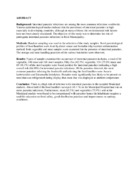| dc.description.abstract | Background: Intestinal parasitic infections are among the most common infections worldwide.
Various epidemiological studies indicate that the prevalence of intestinal parasites is high
especially in developing countries, although in many of these, the environmental risk factors
have not been clearly elucidated. The objective of this study was to determine the risk of
pathogenic intestinal parasites infections in Kisii Municipality.
Methods: Random sampling was used in the selection of the study samples. Stool parasitological
profiles of food handlers were done by direct smear and formalin-ethyl acetate sedimentation
method. Both vegetable and meat samples were examined for the presence of intestinal parasites.
The storage and meat handling practices of the various butcheries were observed.
Results: Types of samples examined for occurrence of intestinal parasites includes, a total of 84
vegetable, 440 meat and 168 stool samples. Fifty five (65.5%) vegetable, 334 (75.9%) meat and
69 (41.1%) of the stool samples were found positive for intestinal parasites indicating a high
overall risk (66.18%) for intestinal parasite infections. Of the parasites detected, the most
common parasites infesting the foodstuffs and infecting the food handlers were Ascaris
lumbricoides and Entamoeba histolytica. Parasites were significantly less likely to be present on
meat that was refrigerated during display than meat that was displayed at ambient temperature.
Conclusion: There is a high risk of infection with intestinal parasites in the sampled Municipal
markets. About half of the food handlers surveyed (41.1 %) at the Municipal Hospital had one or
more parasitic infections. Furthermore, meat (65.5%) and vegetables (75.9%) sold at the
Municipal market were found to be contaminated with parasites hence the inhabitants requires a
need for education on food safety, good distribution practices and improvement on sanitary
conditions. | en_US |
